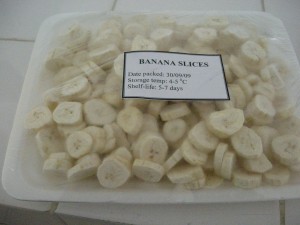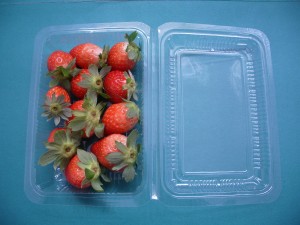 By Roop Soodha Munbodh, research scientist at the Food and Agricultural Research and Extension Institute (FAREI), Mauritius
By Roop Soodha Munbodh, research scientist at the Food and Agricultural Research and Extension Institute (FAREI), Mauritius
This post is part of the ADM Institute’s #PreventPHL blog campaign, following up on the First International Congress on Postharvest Loss Prevention. To read more posts in the series, click here.
Postharvest losses of vegetables and fruits have been estimated to be 25-35% in Mauritius; an island found in the Indian Ocean. The principal causes have been found to be due to rough handling, microbial infestation, mechanical damage of harvested produce as well as inappropriate storage practices and wrong transportation along the marketing channels.
Several research and training initiatives have been taken on at the FAREI to reduce PHL of horticultural crops which have brought significant benefits to the farming community.
Our research analyses include shelf life evaluation of produce (vegetables, fruits, fine herbs, flowers) under recommended packing and storage conditions. Using bagging and de-greening techniques, pre and postharvest losses of commercial crops such as litchis, banana, and pineapple have been reduced. We are also regrouping the use of technologies (hydro-cooling, waxing, curing, packaging, cold chain) as well as GAP principles to maintain quality and shelf life of produce for supply to local and export markets.
The FAREI turns research outcomes into capacity building for farmers and operators along the marketing chain, including the Agricultural Marketing Board, through training programmes, demonstrations, and visits. For example, after trials were conducted on minimal processing practices of vegetables and fruits of economic importance (different cutting types were tested as well as different packaging of plastic bags, clip-on barquettes, or by vacuum and cold-stored), we then provided training to potential entrepreneurs at the Postharvest Facility at Wooton C.R.S.
Many growers need support in meeting EUREPGAP norms for export of crops, and we have provided training on best postharvest, handling, packaging, health and safety, and risk management practices for growers of citrus fruits, leafy greens, hearty vegetables, and many other horticultural products. Through these trainings, many growers and operators have been sensitized about good handling and storage practices for a wide variety of crops.
In addition to training workshops, FAREI hosts meetings to facilitate technology transfer and to obtain feedback on experiences with colleagues from both research & extension and with the farming community.
Several publications have been published to support the farming community, as well. These include fact sheets, guidelines for harvesting, handling, packing, and storage of various crops, and booklets.
Some publications and lectures to note include:
- Booklet: La culture de l’arbre a pain’ a Maurice,
- Two scientific papers were also published: Quality attributes of Marquise strawberry variety (STASM 2003) & Effect of temperature and packaging on the shelf life of two strawberry cultivars (AMAS 2002),
- Public lecture on“Poste recolte des fleurs coupes’ at the Municipality of Rose Hill,
- Public lecture on ‘Harvest and Postharvest breadfruit’ in April 2012 at the Farmer Training School at Wooton.
These publications were produced following storage trials on high-yielding varieties of vegetables or fruits which were subjected to different packaging and storage conditions and the shelf life monitored in terms of marketability, firmness, brix, acidity and weight loss. Publications on the reduction of postharvest losses and improvement of marketability of horticultural produce for the local and export markets are also available at the FAREI extension service.
Some of the fruits and vegetables assessed:
 Carrots, pineapple, squash, fine beans, garlic, onion, mushroom, pepino, roselle, starfruit, papaya, cassava, moringa leaves, lettuce, cauliflower, broccoli, pomegranate, jackfruit, sweet pepper, breadfruit, tarrow leaves, sweet pepper, tomato, strawberry, litchi, melon, avocado, passion fruit, mango chilies, cucumber, guava, melon, breadfruit, asparagus, and local lemon
Carrots, pineapple, squash, fine beans, garlic, onion, mushroom, pepino, roselle, starfruit, papaya, cassava, moringa leaves, lettuce, cauliflower, broccoli, pomegranate, jackfruit, sweet pepper, breadfruit, tarrow leaves, sweet pepper, tomato, strawberry, litchi, melon, avocado, passion fruit, mango chilies, cucumber, guava, melon, breadfruit, asparagus, and local lemon
Future work
The first postharvest unit was set in 1999 in order to provide laboratory facilities for postharvest research and for training. The main research objectives of the postharvest unit being: to reduce postharvest losses of horticultural produce and increase shelf life of perishable fresh produce in order to improve their marketability, to increase availability of seasonal produce and add value to horticultural produce through novel postharvest treatments and packaging in order to increase their marketing potential locally and on the export front. The postharvest Unit intends to carry out projects on the use of ethylene absorbers, coating materials and new packaging technology to further its objectives. Emphasis will also be on Rapid Detection Methods of pesticide residues in stored produce prior to exports.
The blog entries in this #PreventPHL series are by students and members of our PHL Prevention community of practice. The opinions expressed are those of the individual authors and do not necessarily reflect the position of the ADM Institute. In addition, none of the statements should be considered an endorsement of any person, product, or technique by the ADM Institute.


No comments yet.